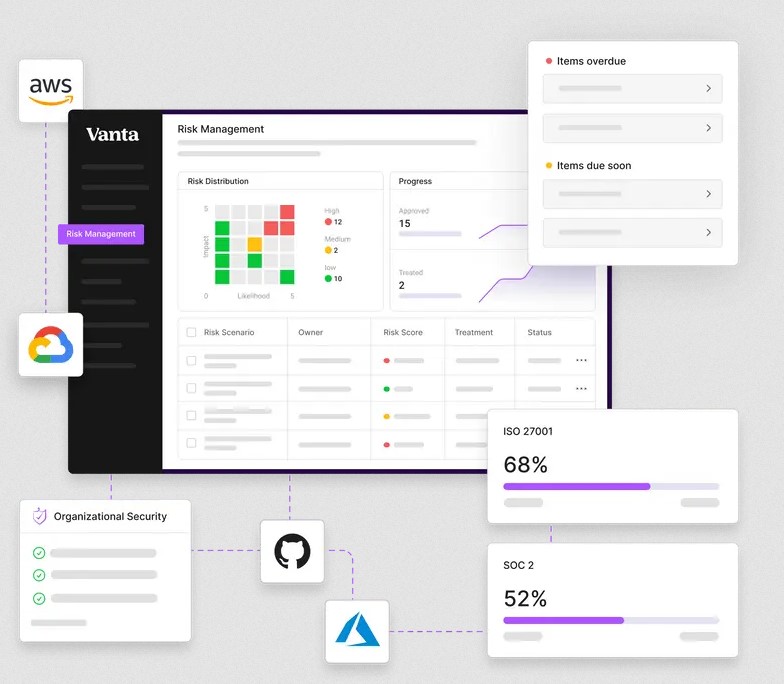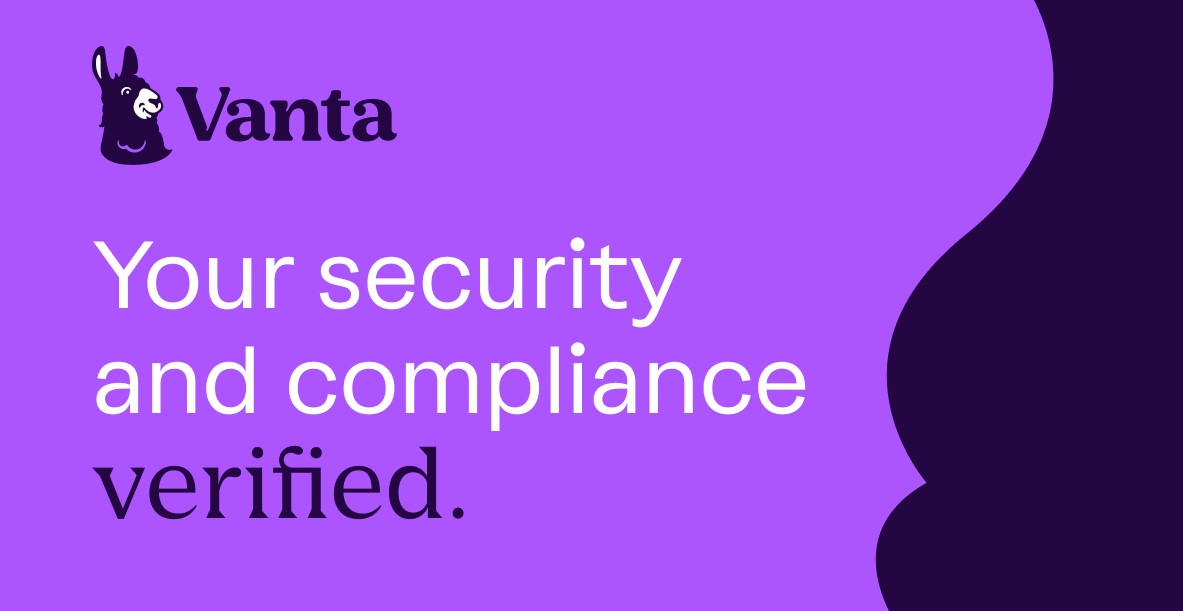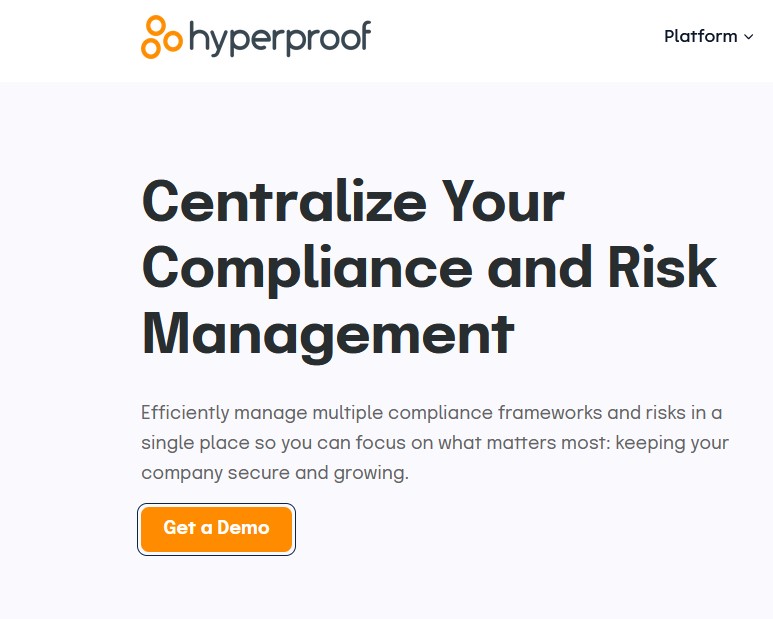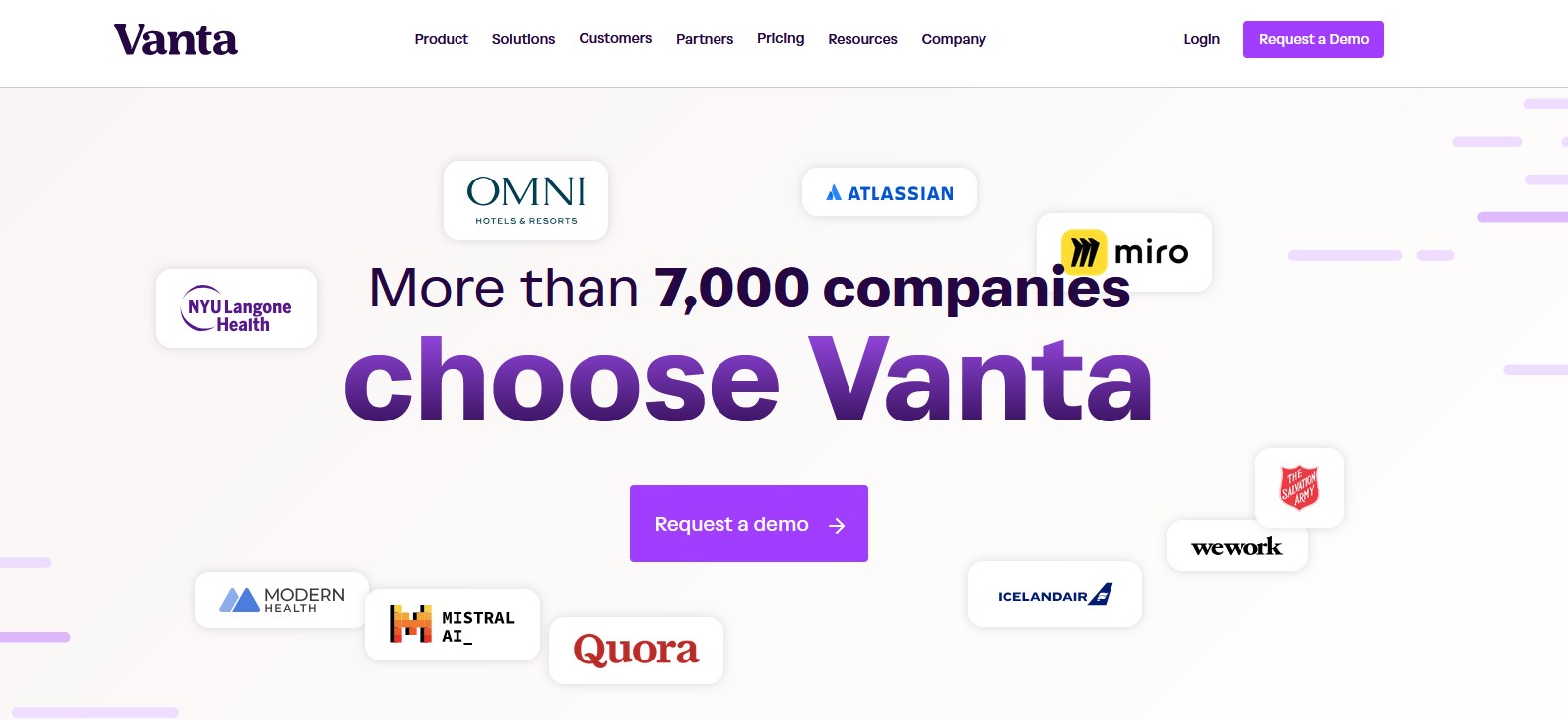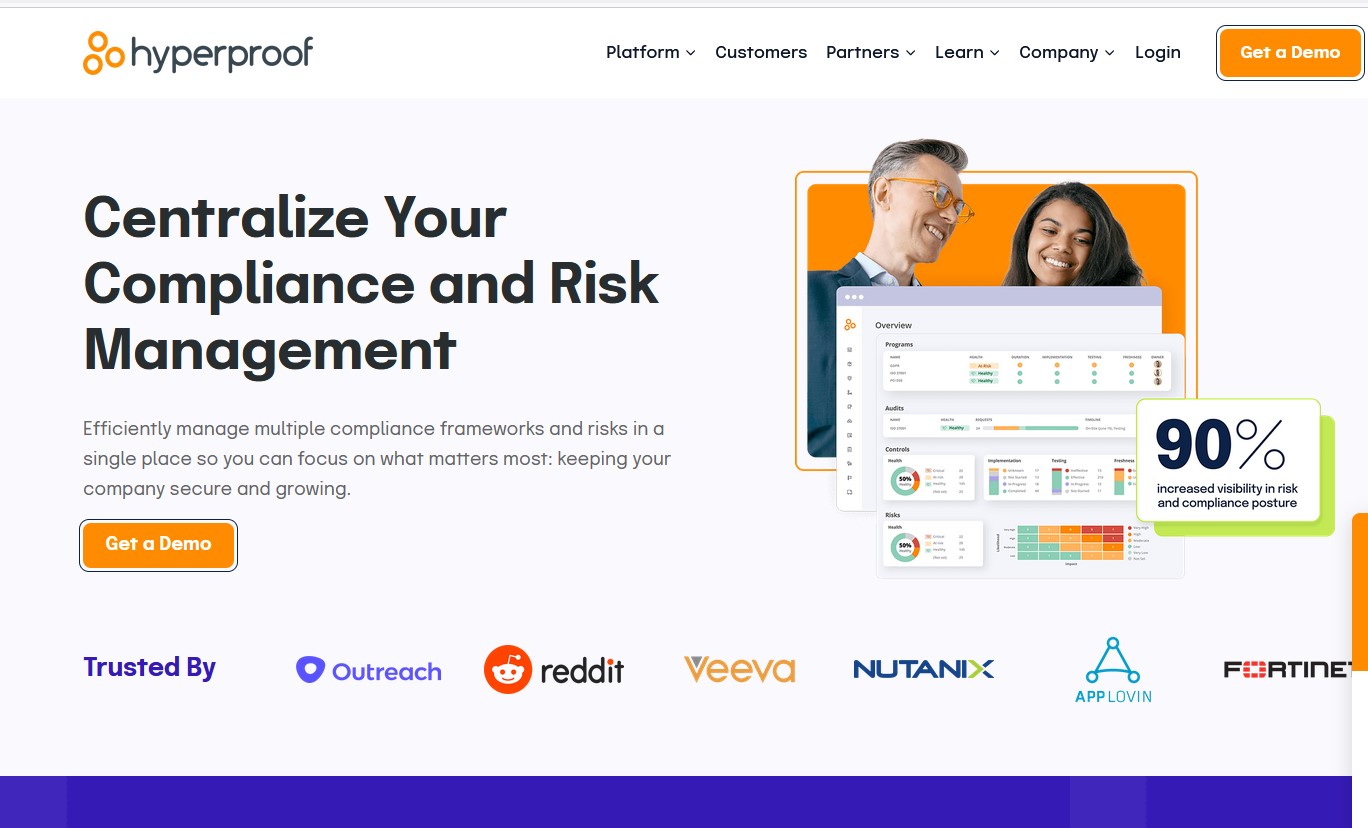Selecting the right compliance management software is essential for organizations striving to streamline compliance processes efficiently. Given the increasing complexity of regulatory requirements, a robust compliance management tool can make a significant difference. This article compares Vanta and Hyperproof, two leading solutions designed to enhance compliance management through automation, collaboration tools, and advanced reporting capabilities.
Whether you are a growing startup or an established enterprise, understanding the strengths and weaknesses of platforms like these is crucial for informed decision-making. Our article aims to summarize key features, pros and cons, target audiences, and pricing models of these tools. In writing this, we intend to help organizations make informed purchasing decisions in the RegTech space that fit their team’s specific compliance needs.
Overview of Compliance Management Software
Effective compliance software helps ensure adherence to changing regulations. They also build trust with customers, investors, and stakeholders by demonstrating a commitment to security and governance. Compliance management software is vital for helping organizations assess risks, implement security measures, and maintain regulatory compliance.
These tools are critical in mitigating the risks of data breaches, regulatory penalties, and reputational damage. They automate and simplify the complex tasks associated with achieving and maintaining compliance. By centralizing compliance activities and documentation, these platforms enable organizations to sustain continuous compliance and quickly adapt to new regulatory requirements.
Vanta and Hyperproof address these challenges in their own ways. Each tool offers features tailored to streamline compliance workflows and enhance organizational resilience. They provide a range of tools to help businesses maintain compliance, reduce administrative burdens, and improve overall security postures.
Methodology
To provide a comprehensive and objective comparison of Vanta and Hyperproof, this evaluation focuses on several critical criteria. By examining these, organizations can gain a clear understanding of each platform’s strengths and weaknesses.
Compliance Framework Support
This criterion evaluates how well each platform supports various compliance frameworks such as SOC 2, HIPAA, ISO 27001, GDPR, and others. The breadth and depth of framework support are essential to determine the tool’s applicability to different industries and regulatory environments. Strong framework support indicates the platform’s ability to help organizations efficiently meet diverse compliance requirements.
Integration Capabilities
Integration capabilities assess how well each platform integrates with other tools and systems within an organization’s tech stack. This includes connections with cloud providers (AWS, Azure), productivity tools (Slack, Google Drive), and other security and compliance tools. Effective integration capabilities enhance operational efficiency, streamline workflows, and ensure seamless data exchange across various systems.
Pricing Models
The pricing models of each platform are analyzed to understand the cost structure, including subscription fees, implementation costs, and any additional charges for advanced features or higher service tiers. Transparent and flexible pricing models are crucial for organizations to budget effectively and avoid unexpected costs. This section also considers the overall value provided by each platform relative to its cost.
User Experience
User experience evaluates the intuitiveness of the user interface, ease of navigation, and overall user satisfaction. This includes the learning curve associated with each platform, the availability of training resources, and the quality of documentation. A user-friendly platform can significantly enhance adoption rates and improve the overall effectiveness of compliance management.
Vendor Reputation
Vendor reputation is assessed by evaluating customer reviews, industry recognition, and overall market presence. A strong vendor reputation indicates reliability, trustworthiness, and a proven track record of delivering high-quality solutions. This section also considers the platform’s history of updates and improvements, reflecting the vendor’s commitment to innovation and customer satisfaction.
Customer Support Quality
Customer support quality examines the availability and responsiveness of customer support services, including the types of support offered (24/7, dedicated account managers, training resources, etc.). Effective customer support is crucial for addressing issues promptly, assisting with onboarding, and providing ongoing assistance to ensure optimal platform use.
Vanta Overview
Vanta stands out for its comprehensive coverage of major compliance frameworks such as HIPAA, SOC 2, GDPR, and ISO 27001. It integrates with over 300 tools, offering real-time monitoring, automated policy management, and detailed reporting ensuring efficient regulatory compliance.
Key Features
- Integration and Compatibility: Supports integrations with over 300 tools and platforms, facilitating seamless workflow integration and operational efficiency across diverse organizational environments.
- Predictable Pricing Structure: Transparent pricing models tailored to organizations of all sizes, providing clarity and flexibility to meet varying compliance needs and budgetary constraints.
- Continuous Monitoring: Real-time alerts and monitoring capabilities enable organizations to promptly identify and address compliance issues, thereby minimizing the risk of data breaches and penalties.
- Automated Policy Management: Simplifies policy creation and maintenance through automation, ensuring consistency and accuracy in compliance documentation.
- Comprehensive Reporting: Detailed analytics and reporting features provide actionable insights into compliance posture and performance metrics, empowering informed decision-making at every level.
Pros:
- Comprehensive Coverage: Supports a wide range of compliance frameworks critical for organizations handling sensitive data, ensuring adherence to stringent regulatory requirements.
- Seamless Integration: With compatibility across numerous organizational tools, Vanta enhances operational efficiency by integrating compliance processes seamlessly into existing workflows.
- Predictable Pricing: Transparent pricing models help organizations manage compliance costs effectively, offering clear visibility into expenditure and facilitating budget planning.
- Continuous Monitoring: Real-time alerts enable proactive risk management, allowing organizations to stay ahead of compliance challenges and potential threats.
- Automated Policy Management: Streamlined policy creation and management reduce manual effort and errors, enhancing efficiency in maintaining compliance documentation.
- Comprehensive Reporting: Detailed analytics provide actionable insights that support strategic decision-making and continuous improvement in compliance strategies.
Cons:
- Initial Pricing: The upfront costs of Vanta may be perceived as high for smaller organizations or startups, potentially posing a barrier to entry for some.
- Learning Curve: New users may require time and training to fully leverage Vanta’s extensive features and functionalities effectively.
- Update Frequency: Some users have noted gaps in enhancements following funding rounds, which may impact the speed of new feature introductions.
- Integration Costs: While Vanta offers extensive integration capabilities, setting up complex integrations may involve additional expenses and resources.
- Progress Tracking: Managing and tracking compliance progress, especially in distributed teams, may present challenges due to the platform’s complexity.
Hyperproof Overview
Hyperproof addresses compliance challenges by offering robust solutions that streamline security assurance and compliance operations. Noteworthy features include innovative “hypersyncs” for seamless evidence collection from cloud-based applications, along with support for frameworks such as NIST and PCI-DSS.
Key Features
- Tasks and Repeating Tasks: Automates routine task management and proof requests through automated reminders, ensuring timely compliance checks and reducing administrative burden.
- Program Health Assessments: Customizable control settings allow comprehensive assessments of a compliance program’s health, maintaining alignment with organizational standards.
- Real-Time System Monitoring: Provides robust capabilities for monitoring control activities and setting expiration periods, crucial for maintaining operational effectiveness and compliance readiness.
- Automated Evidence Collection: Simplifies audit preparation by automatically gathering evidence from external services like AWS, Azure, and GitHub, minimizing manual effort and ensuring audit readiness.
- Integrations: Seamless integration with popular productivity tools such as Google Drive and Slack enhances collaboration and facilitates efficient team workflows in compliance management.
- Custom Fields: Allows tailoring of compliance processes by applying custom fields to controls and tasks, enhancing flexibility and adaptability.
- Advanced Scoping Capabilities: Categorizes and manages controls based on organizational sectors, providing comprehensive oversight and ensuring regulatory compliance across diverse operational domains.
Pros:
- Intuitive UX/UI: User-friendly interface designed for effortless navigation, minimizing the learning curve and ensuring smooth user experiences.
- Responsive Customer Support: Ensures prompt issue resolution and expert guidance throughout the compliance journey.
- Efficient Implementation: Facilitates swift integration into existing systems, minimizing disruption and accelerating compliance solution deployment.
- Customizable Features: Flexible product configurations allow organizations to tailor Hyperproof to specific compliance needs and adapt to evolving organizational requirements effectively.
Cons:
- Limited Functionality: Opportunities exist for expanding its feature set to accommodate a wider range of diverse compliance needs and industry-specific requirements.
- Automation Challenges: Enhancements in automation capabilities could further optimize operational efficiency and reduce manual intervention in compliance processes.
- Usability Issues: Improvements in intuitiveness and user-friendliness could enhance user adoption rates and overall satisfaction with the platform.
- Learning Curve: Initial complexity may require some time for users to familiarize themselves fully with Hyperproof’s features and functionalities.
Target Audience
Vanta appeals to:
- Organizations requiring comprehensive compliance coverage across multiple frameworks such as HIPAA, SOC 2, GDPR, and ISO 27001.
- Businesses seeking seamless integration with a diverse range of tools and platforms.
- Companies prioritizing the use of AI in streamlining their compliance processes.
Hyperproof caters primarily to technology companies. It is ideal for:
- Businesses looking to automate compliance workflows and enhance collaboration across various stages of development.
- Teams managing complex compliance requirements across multiple sectors and industries.
- Organizations needing centralized compliance documentation and advanced reporting tools for streamlined compliance management.
In-depth Reviews of Vanta and Hyperproof
Here are a couple of in-depth reviews of these leading compliance management platforms.
Vanta Review
Vanta excels in comprehensive compliance coverage, seamless integration capabilities, and proactive compliance management through real-time monitoring and automated policies.
Key Takeaways
- Integration and Compatibility: Supports over 300 integrations for operational efficiency and system compatibility.
- Predictable Pricing: Transparent pricing models ensure budgetary clarity and predictability.
- Continuous Monitoring: Real-time alerts minimize compliance risks and enhance proactive management.
- Policy Management: Automated creation and maintenance ensure accuracy in compliance documentation.
- Comprehensive Reporting: Detailed analytics provide actionable insights for informed decision-making.
Pricing and Value
Vanta offers long-term value through comprehensive compliance coverage and operational efficiency, despite potentially higher initial costs. Organizations benefit from Vanta’s ability to scale alongside their compliance needs, making it suitable for both small businesses and large enterprises alike.
Hyperproof Review
Hyperproof focuses on automating compliance workflows, enhancing collaboration, and centralizing compliance documentation to streamline audit preparations and maintain continuous compliance. It’s a much smaller player than Vanta, and may have some smaller-player problems, particularly around robustness of offering or extent of capabilities.
Key Takeaways
- Workflow Automation: Automates compliance tasks for efficiency and consistency.
- Centralized Documentation: Stores evidence centrally for audit readiness and reduced administrative overhead.
- Collaboration Tools: Enhances team productivity through task management and shared workflows.
- Reporting and Analytics: Provides insights for continuous compliance improvement.
Pricing and Value
Hyperproof’s focus on workflow automation, collaboration tools, and centralized documentation offers value for organizations seeking streamlined compliance management. Hyperproof’s pricing info is not readily available online, but can be acquired by providing Hyperproof with your business email and some details about your tech needs.
Conclusion
Choosing between Vanta and Hyperproof depends on your organization’s specific needs and priorities. Each platform offers unique strengths and capabilities to address various aspects of compliance management. For instance, Vanta might be more suitable for organizations requiring extensive framework coverage and seamless integration with numerous tools. On the other hand, Hyperproof could be ideal for tech companies seeking robust automation and collaboration features.
To make an informed decision, consider the following factors:
- Compliance Framework Coverage: Evaluate which platform better supports the regulatory frameworks your organization must adhere to, such as SOC 2, HIPAA, ISO 27001, or GDPR. Vanta excels in multi-framework support, while Hyperproof offers comprehensive support with detailed workflow automation.
- Integration Capabilities: Assess the integration capabilities of each platform. Vanta integrates with over 300 tools, providing flexibility and scalability, while Hyperproof focuses on enhancing collaboration through seamless integrations with existing systems.
- Pricing Models: Compare the pricing structures of Vanta and Hyperproof to determine which offers the best value for your organization. Vanta’s transparent pricing model is based on the number of employees and compliance frameworks needed, offering significant long-term savings by reducing compliance risks. Hyperproof’s tiered pricing plans cater to businesses of all sizes, providing cost-effective solutions that improve operational efficiency.
- User Experience: Consider the ease of use and overall user experience. Vanta is known for its rapid implementation and user-friendly interface, though it may pose challenges for new users. Hyperproof’s intuitive interface and collaboration tools enhance team productivity, but may require familiarization for maximum utilization.
Both Vanta and Hyperproof provide robust solutions tailored to specific compliance challenges. By carefully evaluating these aspects, organizations can select the compliance management platform that best aligns with their operational goals and regulatory requirements.
